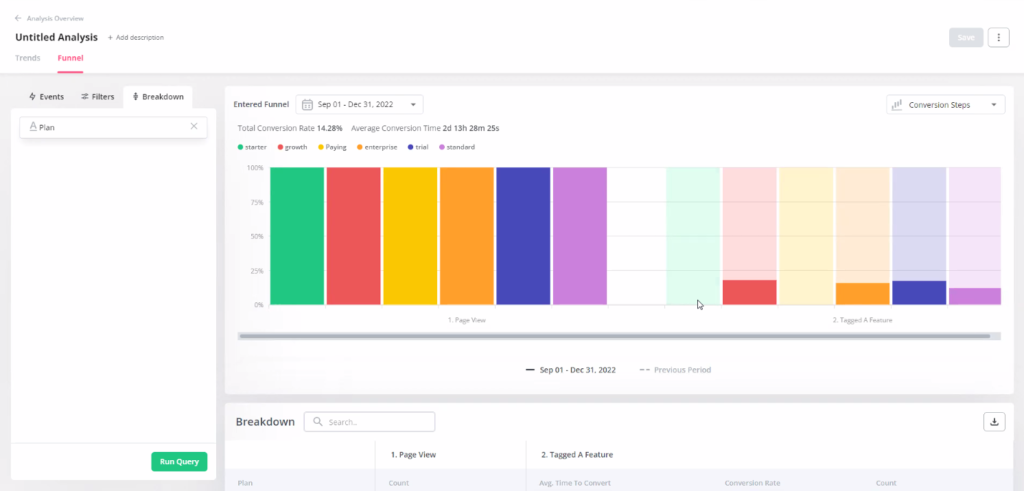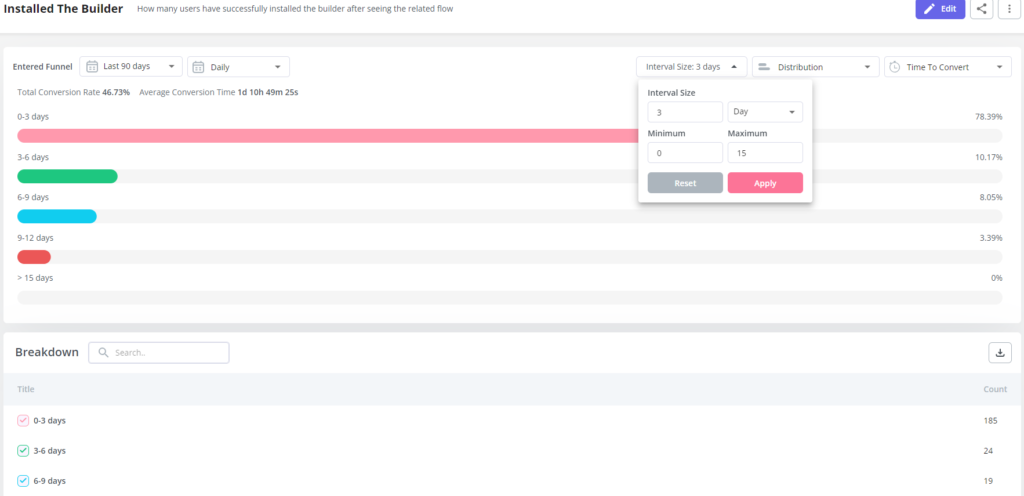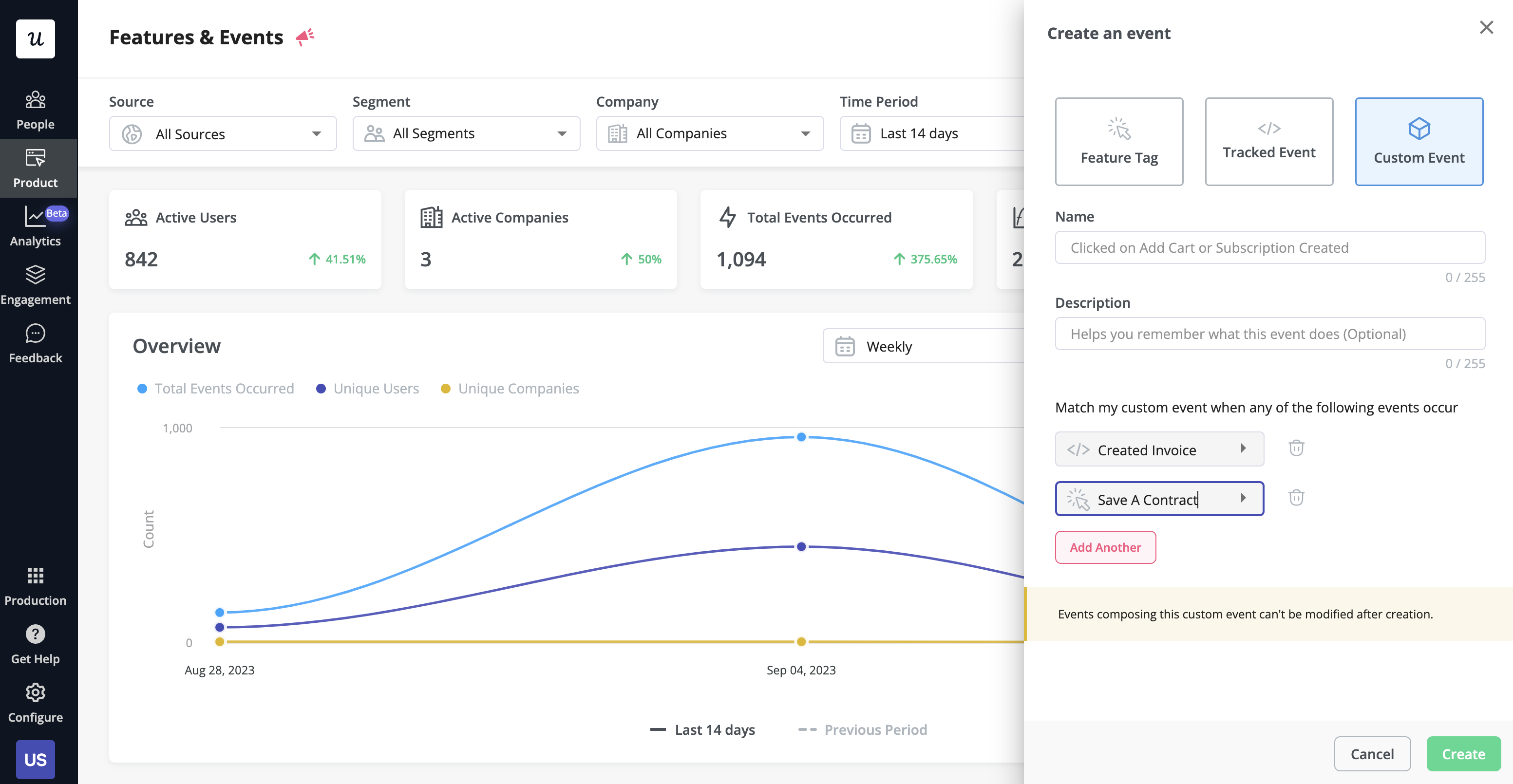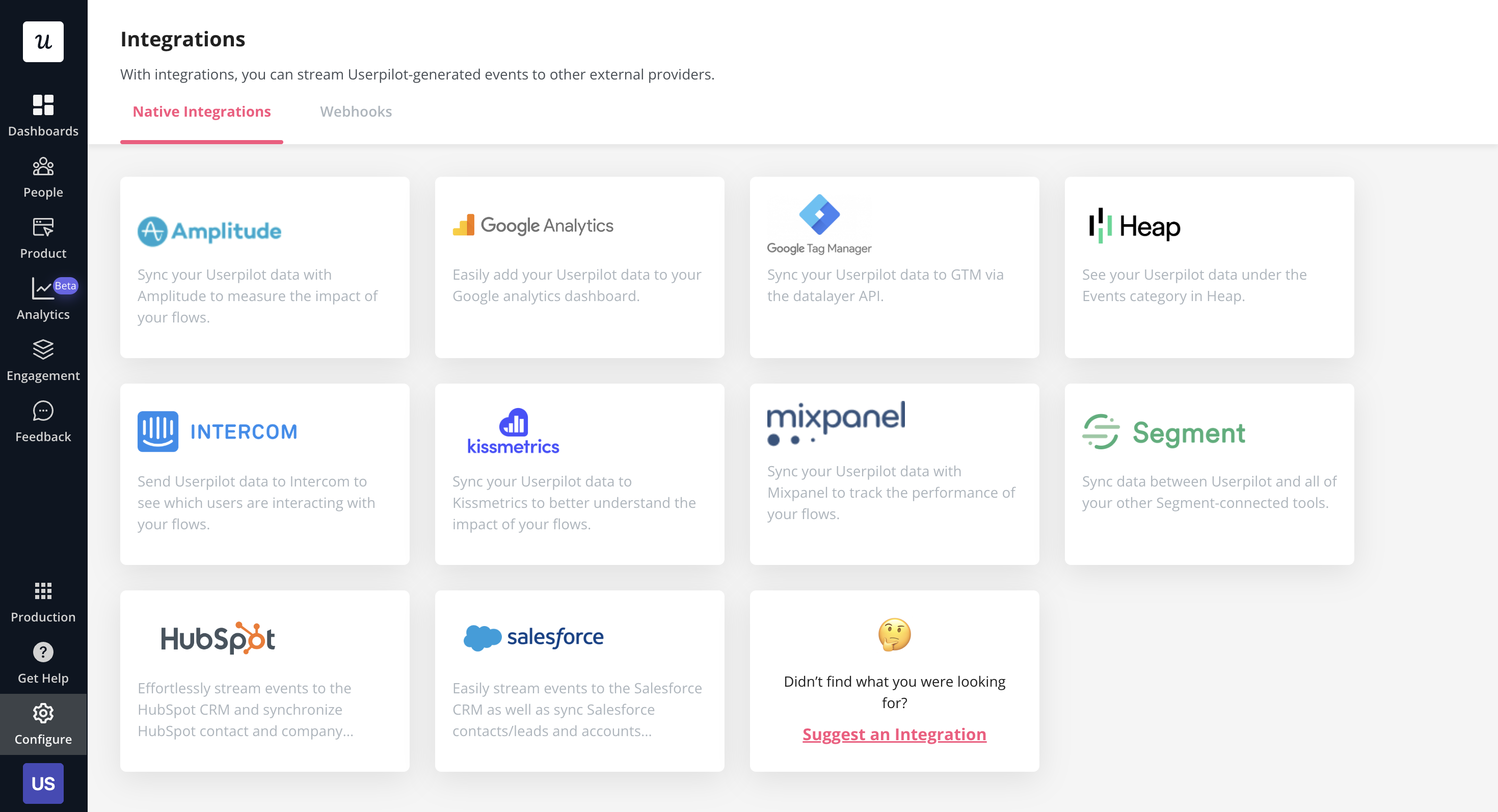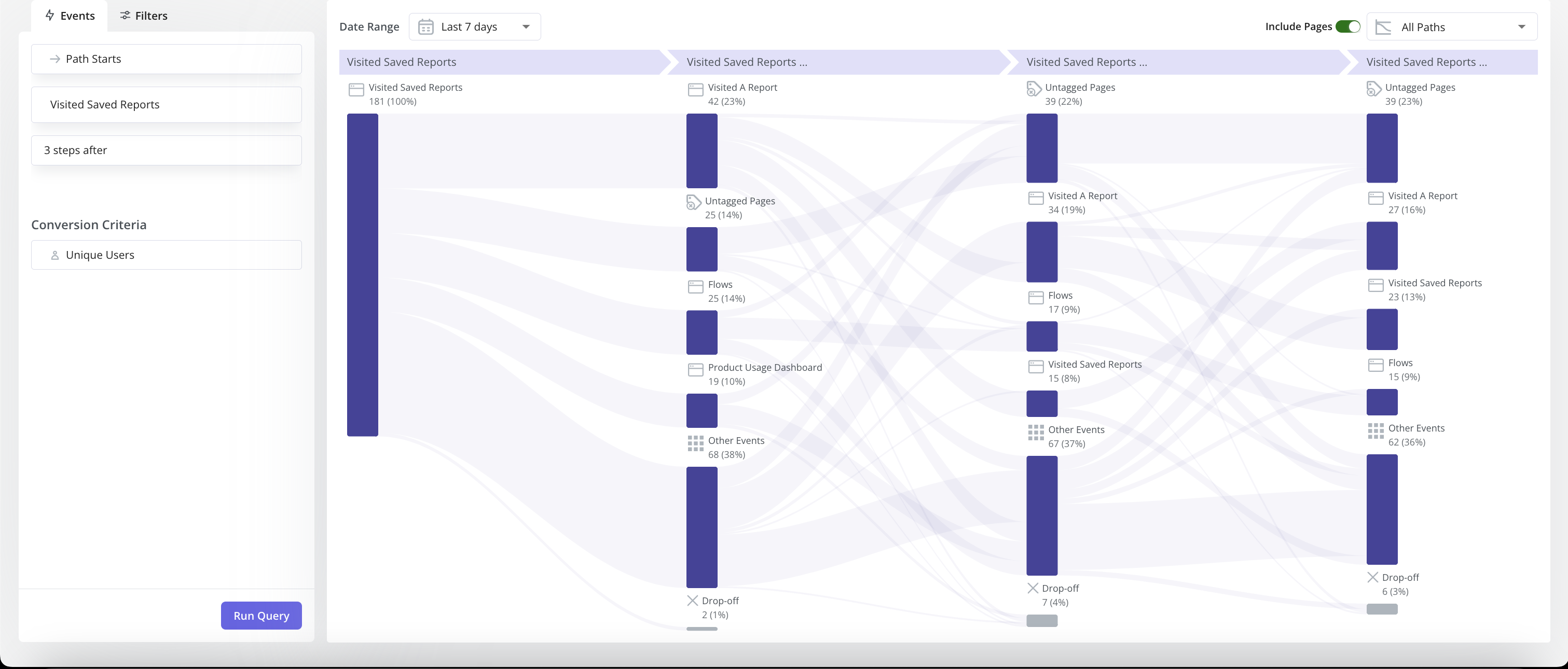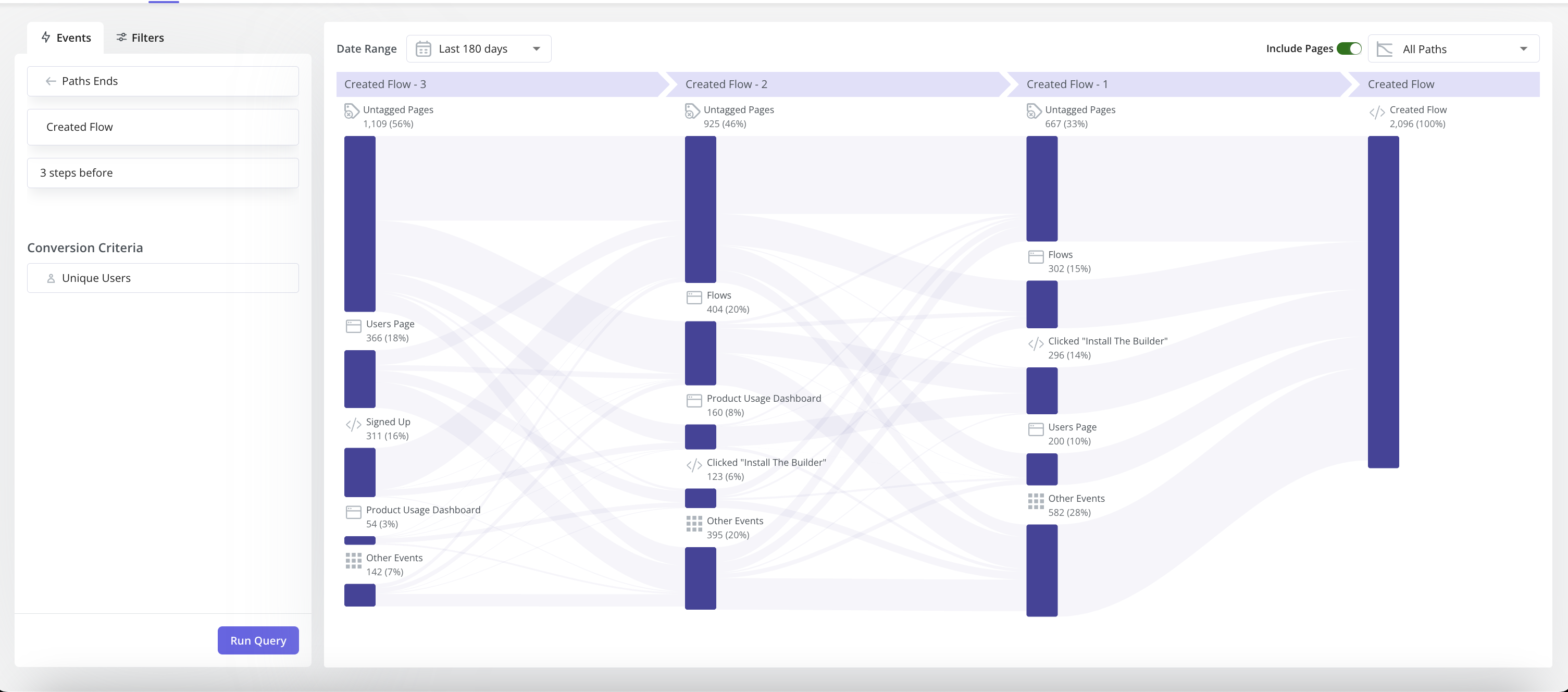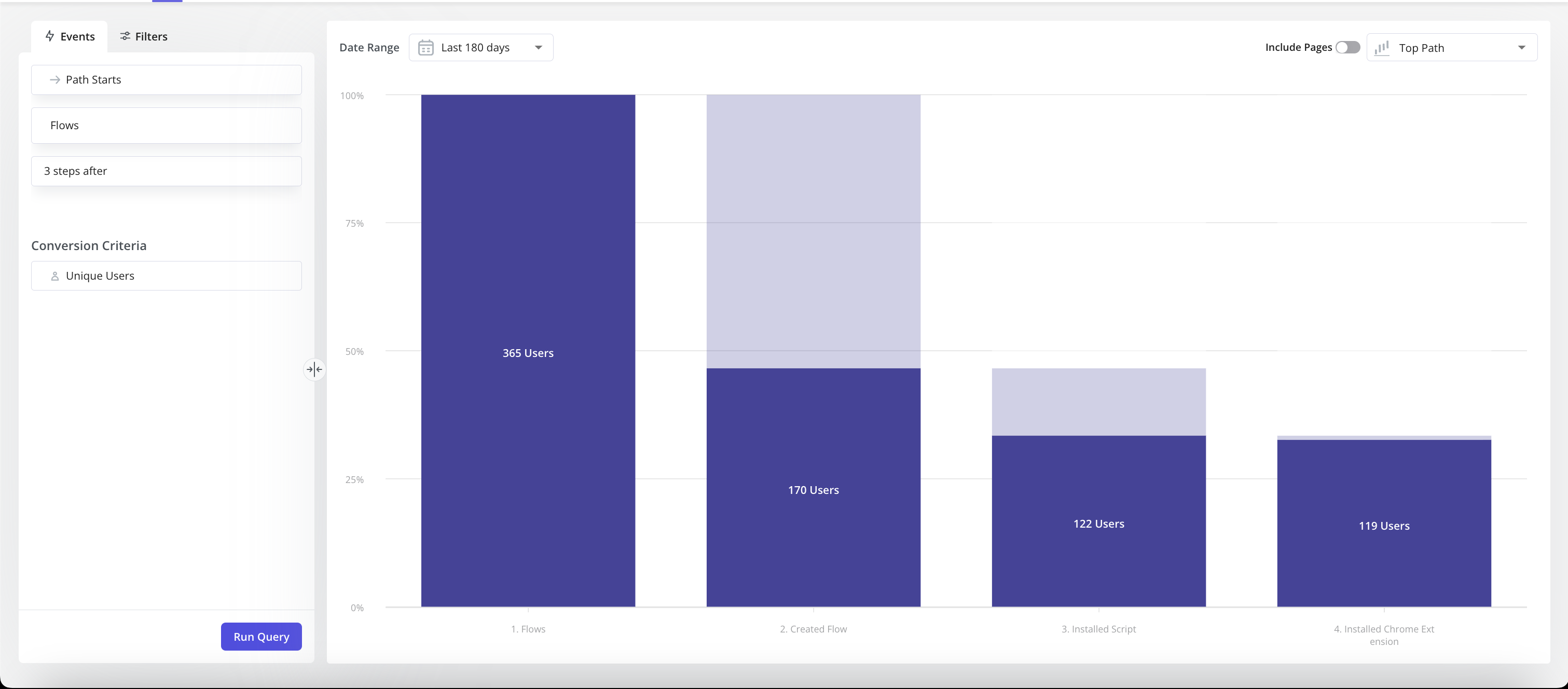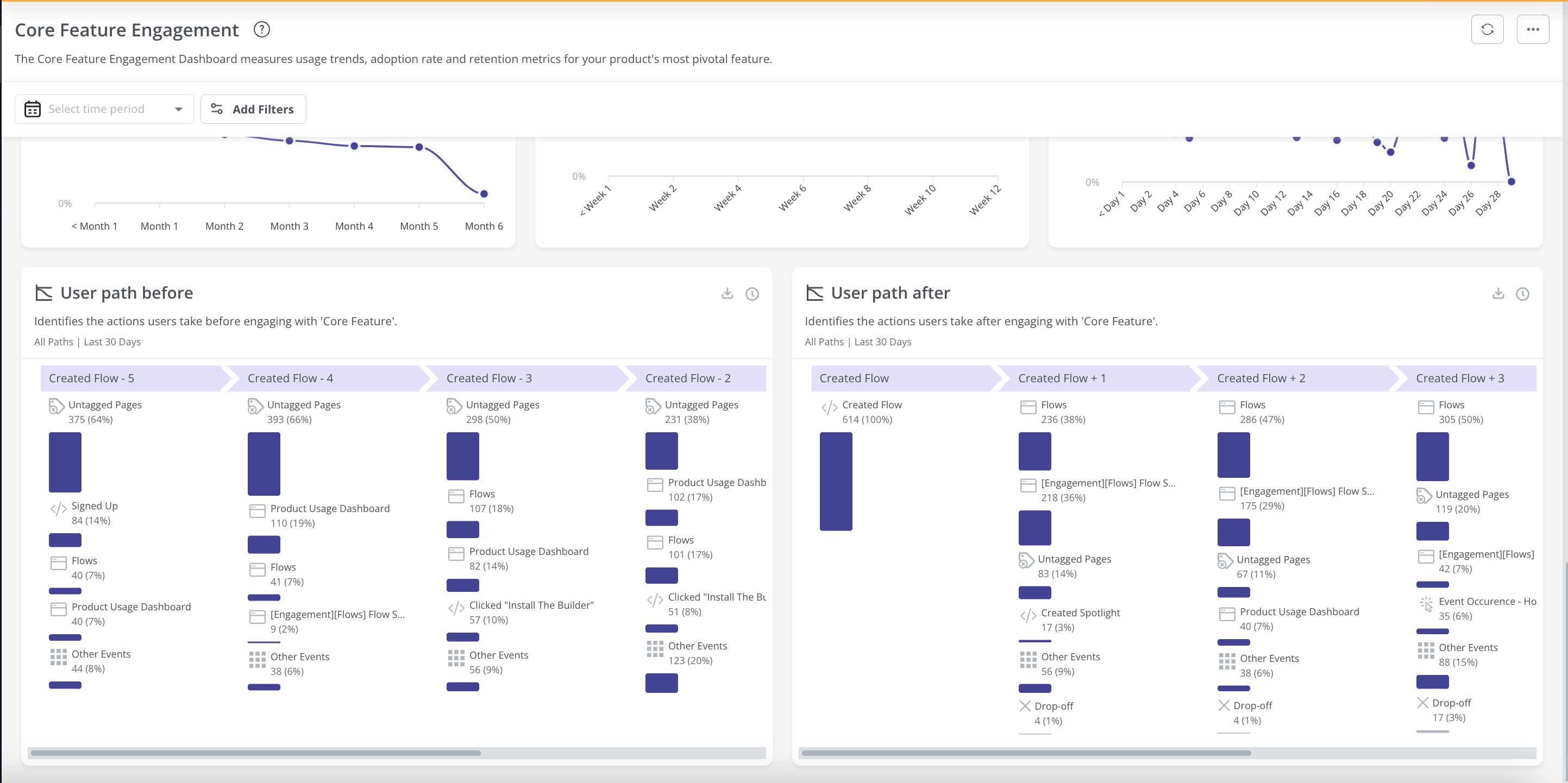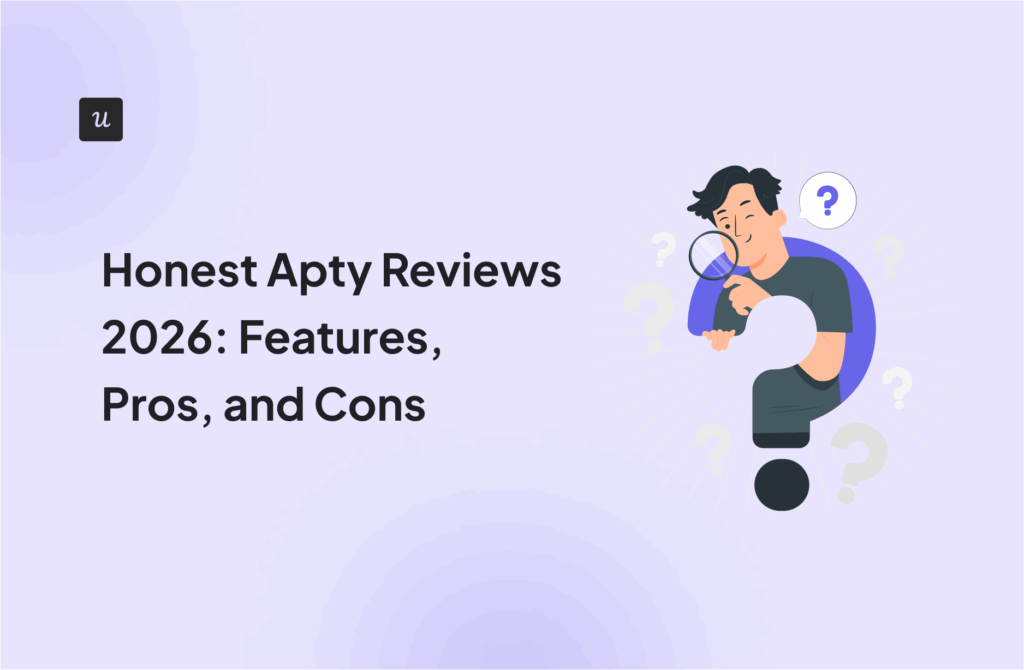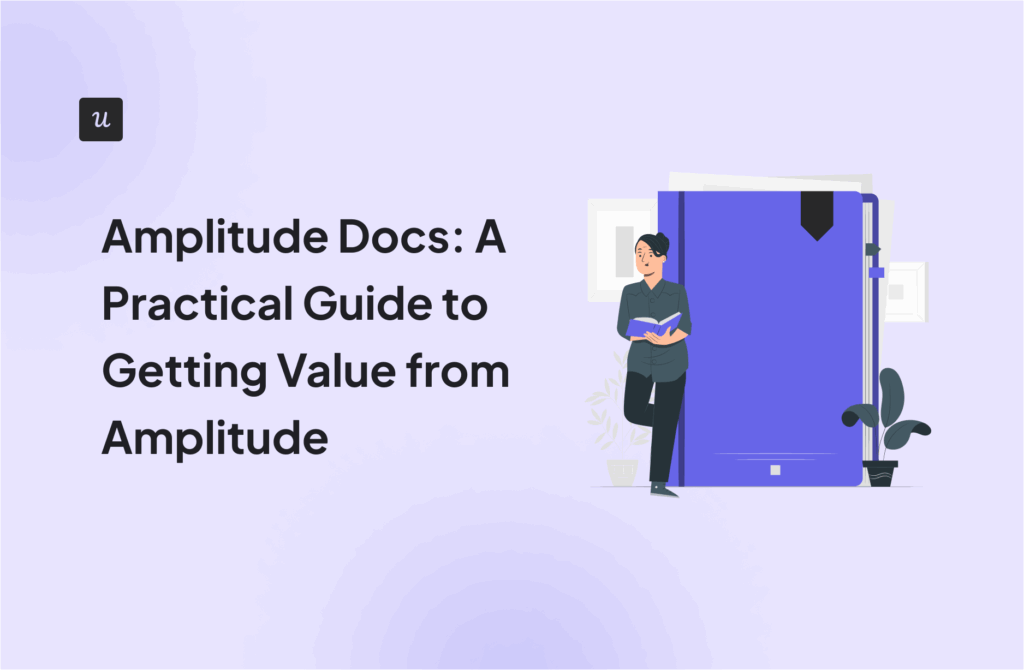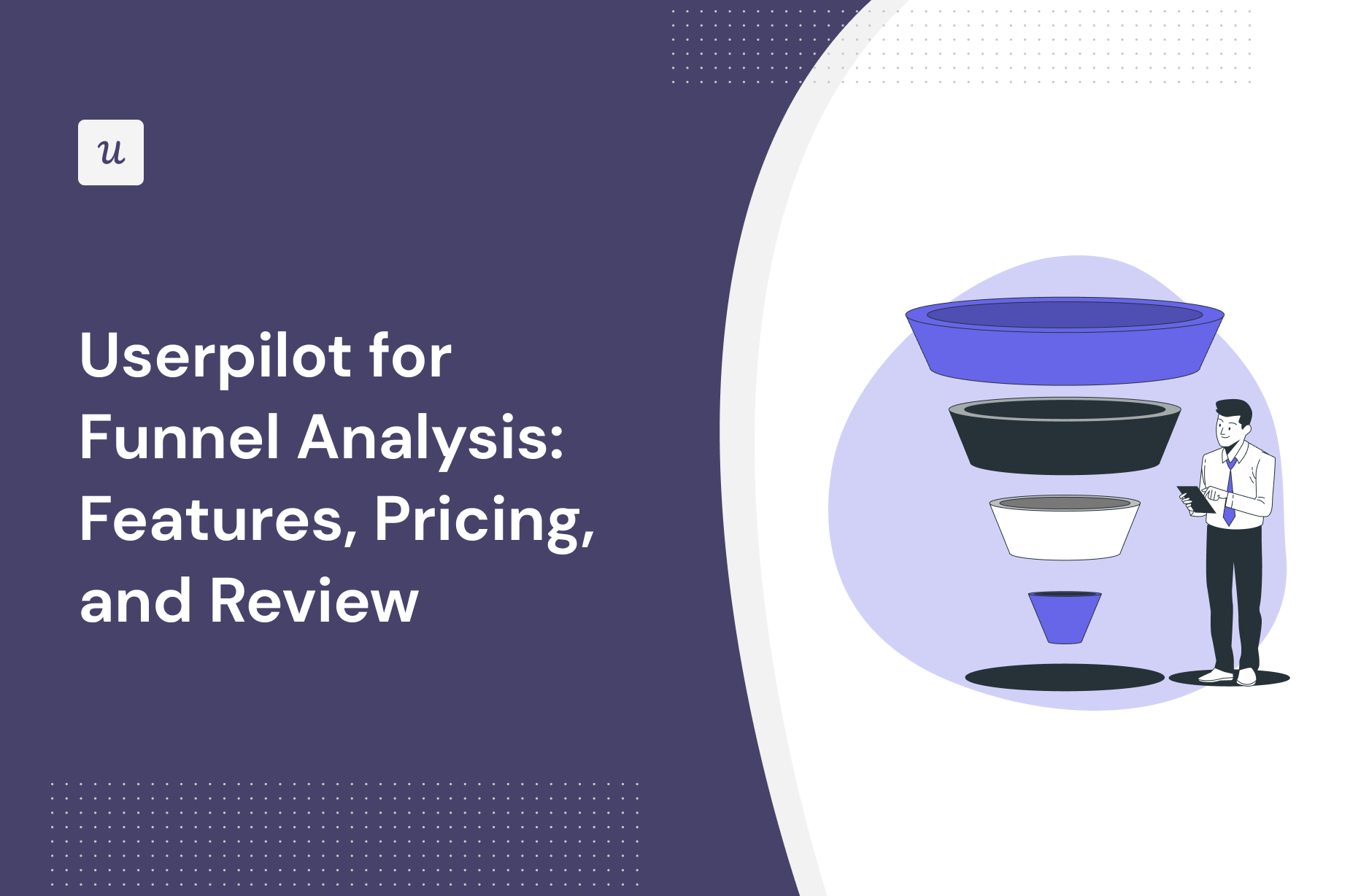
Try Userpilot Now
See Why 1,000+ Teams Choose Userpilot

Must have the features of funnel analysis tools
When considering a tool for analyzing your user behavior through conversion funnels, here are the features to look out for:
- User segmentation: To detect behavioral patterns amongst common groups and segment users by shared characteristics like user roles or JTBDs. Such insights enable tailored strategies, potentially boosting conversion rates.
- Event tracking: To allow you to track user events at each stage of the funnel. Events could include pageviews, form submissions, sign-ups, and more.
- A/B testing: To experiment with UI changes and use funnel comparisons to measure performance improvements against old flows. This helps in improving the user experience and conversion paths.
- Customizable funnels: Defining and customizing your funnels is crucial. You should be able to specify the stages, actions, and events that make up your funnel.
- Additional product analytics features: To validate hypotheses with heat maps, session recordings, and other important user analytics features.
Userpilot features for funnel analysis
Tracking user funnels is essential to getting a deeper understanding of the customer journey and reducing friction points. Userpilot helps you track user funnels by creating funnel reports, reviewing saved reports in bulk, and seeing key metrics like the average time it takes to complete a funnel.
Here’s how you can use Userpilot to generate funnel charts:
- Funnels: Userpilot’s funnel reports can show you the percentage of users that progress from one stage to another. Stages could consist of pages, actions, or other activation points. You can also set a specific order that these steps need to be completed or adjust the time period.
- Reports: The saved reports area of your Userpilot account lets you view, edit, duplicate, delete, or export (as a CSV file) all the analytics reports that you (or your teammates) have generated. You can also filter results by the teammate who created the report or the type of report.
- Duration: The granular funnel analytics can offer more insights into each stage of a particular user funnel, such as how long it took the majority of your users to complete it from start to finish. You can filter by time period and set minimum/maximum parameters to remove outliers.
Userpilot’s in-app events
Tracking and analyzing event data gives you a better understanding of user behavior so you can capitalize on opportunities to improve the in-app experience.
Here are the ways you can use Userpilot as an event-tracking tool:
- Event tracking: The Userpilot flow builder lets you track custom events by tagging individual features (Feature Tag), by API (called Tracked Events) or by setting them up using a combination of feature tags and tracked events (Custom Events).
- Data integrations: Userpilot has native integrations with popular analytics tools like Amplitude, Mixpanel, Google Analytics, and more. This makes it possible to sync your event data across multiple tools within your tech stack.
Userpilot’s funnels
Tracking user funnels is essential to getting a deeper understanding of the customer journey and reducing friction points. Userpilot helps you track user funnels by creating funnel reports, reviewing saved reports in bulk, and seeing key metrics like the average time it takes to complete a funnel.
Here’s how you can use Userpilot to generate funnel charts:
- Funnels: Userpilot’s funnel reports can show you the percentage of users that progress from one stage to another. Stages could consist of pages, actions, or other activation points. You can also set a specific order that these steps need to be completed or adjust the time period.
- Reports: The saved reports area of your Userpilot account lets you view, edit, duplicate, delete, or export (as a CSV file) all the analytics reports that you (or your teammates) have generated. You can also filter results by the teammate who created the report or the type of report.
- Duration: The granular funnel analytics can offer more insights into each stage of a particular user funnel, such as how long it took the majority of your users to complete it from start to finish. You can filter by time period and set minimum/maximum parameters to remove outliers.
Userpilot’s paths
Path reports are essential for understanding user flows and journeys, offering invaluable insights into their interactions with our platform or application.
Within the Paths chart(s) visualization in Userpilot, you can:
- See the different flows/links users take from one step/event to another.
- Choose how many steps after or before the starting/ending event you want to report Users’ flows for.
- Choose whether you want to include Pages (i.e. Both User-Tagged and Untagged) in the visualization.
- Change the period of the analysis.
- Change the way you want to view the analysis: All Paths vs. Top Path (i.e. most common).
- Narrow down the targeted end-users by applying global or inline (event-specific) filters.
- View a breakdown of the end-users (or their associated companies) upon clicking on a specific node/step in the visualization chart.
You also have automatic path analysis in Userpilot’s core feature engagement analytics dashboards without having to set up anything. This will give you an overview of user navigation and engagement with your product so you have insights to work on improving their experience.
What are the pros and cons of Userpilot?
Userpilot’s pros
As a full-suite digital adoption platform, Userpilot has all the features you need to onboard users, track analytics, and gather feedback from customers without writing a single line of code. Here are a few pros of using Userpilot as your product growth solution:
- No-code builder: Userpilot’s Chrome extension lets you build flows, add UI elements, and tag features without writing a single line of code.
- UI patterns: There are plenty of UI patterns to choose from when using Userpilot, such as hotspots, tooltips, banners, slideouts, modals, and more!
- Startup-friendly: Userpilot’s entry-level plan gives you access to all available UI patterns so you can hit the ground running.
- Walkthroughs and flows: Build engaging interactive walkthroughs and personalized onboarding flows that target specific segments of your user base.
- Self-service support: Build an in-app resource center to help users solve problems, customize its appearance to align it with your brand, and insert various types of content (videos, flows, or chatbots) to keep your customers satisfied.
- A/B testing: Userpilot’s built-in A/B testing capabilities will help you split-test flows, iterate on the best-performing variants, and continually optimize based on user behavior.
- Feedback collection: Userpilot has built-in NPS surveys with its own unified analytics dashboard and response tagging to help you retarget users. There are other survey types to choose from and you can even create your own custom survey.
- Survey templates: There are 14 survey templates to choose from so you can gather feedback on specific features or run customer satisfaction benchmarking surveys like CSAT and CES.
- Advanced analytics: Userpilot lets you analyze product usage data, monitor engagement on all in-app flows, and use the data to create user segments that are based on behaviors instead of demographics.
- Event tracking: Userpilot’s no-code event tracking lets you tag UI interactions (hovers, clicks, or form fills) and group them into a custom event that reflects feature usage.
- Third-party integrations: Userpilot has built-in integrations with tools like Amplitude, Mixpanel, Kissmetrics, Segment, Heap, HubSpot, Intercom, Google Analytics, and Google Tag Manager so you can share data between all the solutions in your tech stack.
Userpilot’s cons
Of course, no tool is perfect and there are a few cons to consider before choosing Userpilot as your user onboarding or product growth solution:
- Employee onboarding: Currently, Userpilot only supports in-app customer onboarding.
- Freemium plan: There’s no freemium Userpilot plan so those bootstrapping their startup and need sub-$100 solutions should consider more affordable onboarding platforms like UserGuiding or Product Fruits.
What do users say about Userpilot?
Most users laud Userpilot for its versatile feature set, ease of use, and responsive support team:
I recently had the pleasure of using Userpilot, and I must say it exceeded all my expectations. As a product manager, I’m always on the lookout for tools that can enhance user onboarding and improve overall user experience. Userpilot not only delivered on these fronts but also went above and beyond with its impressive new features, unparalleled ease of use, and truly exceptional customer support.
What truly sets Userpilot apart is its outstanding customer support. Throughout my journey with Userpilot, the support team has been responsive, knowledgeable, and genuinely dedicated to helping me succeed. Whenever I had a question or encountered an issue, their support team was always there to assist promptly, going above and beyond to ensure my concerns were addressed effectively.
Source: G2.
Of course, other users are also kind enough to share constructive criticism regarding specific features like event tracking filters:
“The filtration while analyzing specific events is a little confusing. Understanding of custom properties and data management configuration could have been more organised.”
Source: G2.
Userpilot’s pricing
Userpilot offers flexible pricing based on your monthly active users (MAUs). Plans start at $299 per month for smaller teams and scale as your user base grows.
Below are the pricing tiers you can choose from:
- The Starter plan begins at $299/month (billed annually) for up to 2,000 monthly active users. It includes in-app user engagement, usage trend analysis, NPS surveys, and essential product analytics—ideal for mid-market SaaS teams getting started.
- The Growth plan offers custom pricing and adds advanced analytics, retroactive event auto-capture, in-app surveys, session replay, and more. It’s the most popular choice for growing teams that need deeper insights and scale.
- The Enterprise plan offers custom pricing and includes everything in Growth, plus bulk data handling, custom roles and permissions, SOC 2 Type 2 compliance, and enterprise-level support.

Conclusion
There you have it.
It should be easier now to make an informed decision whether Userpilot is your go-to option for funnel analysis. Ultimately, the best choice will depend on your product and current needs.
Book a Userpilot demo today to experience firsthand how it can enhance your user experience and drive product growth!


